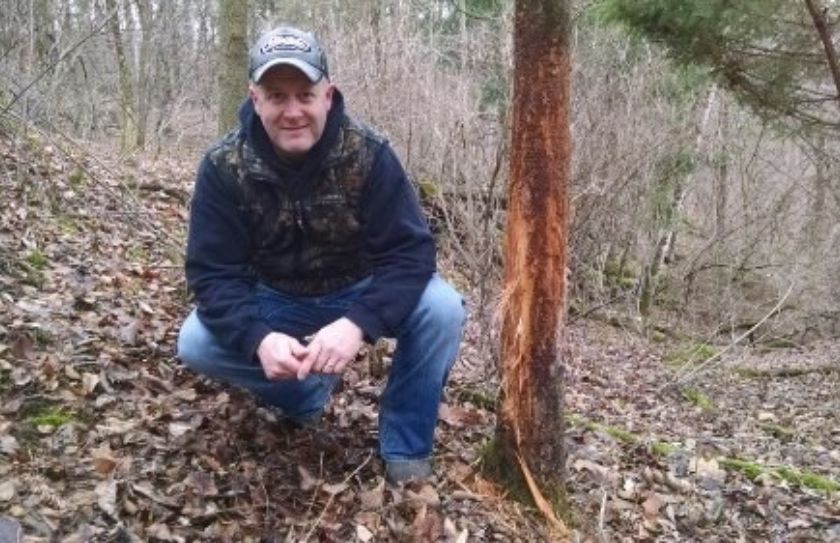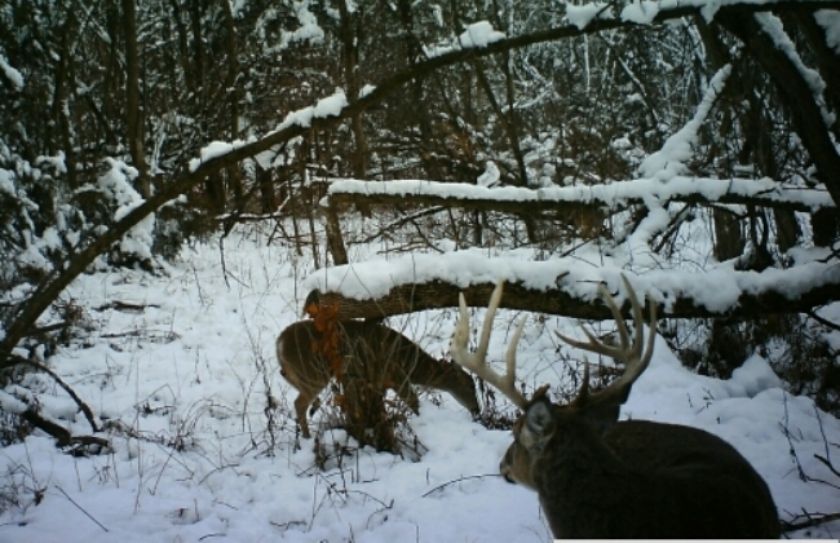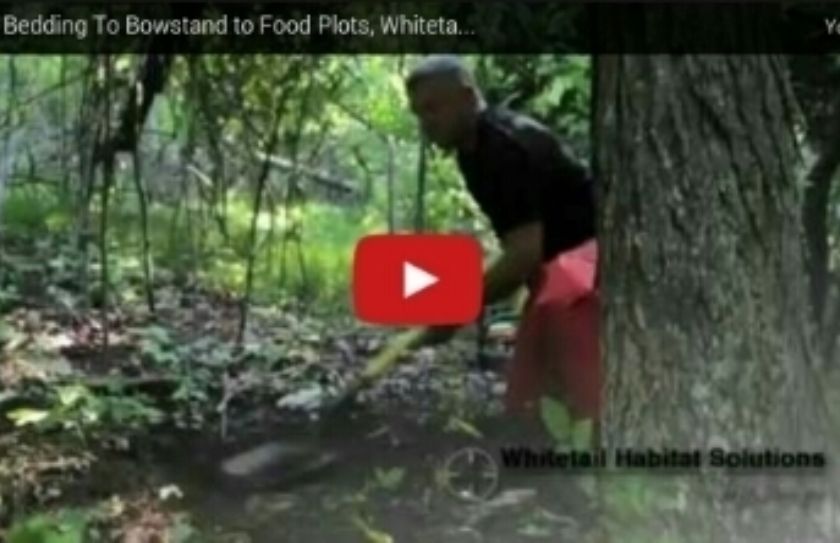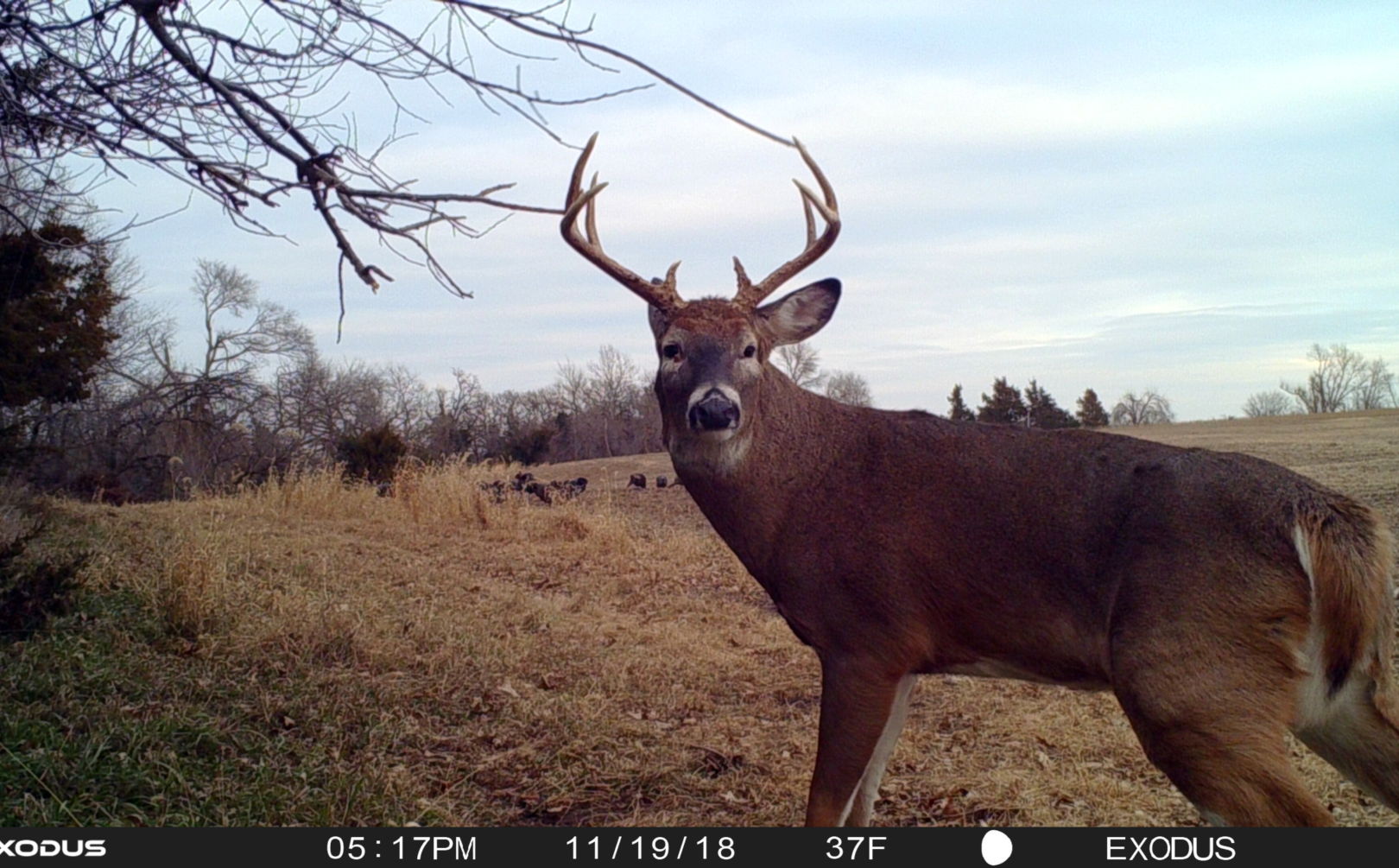
One of the most common questions that I hear, is "where does a buck bed?". That question is one of the most important questions that you can ask yourself as it relates to your own hunting land, because the level of certainty that you can answer with, reveals a great deal about your potential success. Discovering where any whitetail chooses to hide from predators, hunters and other deer, will offer you an intimate look into an important aspect of whitetail behavior. However, if you can pinpoint a reclusive old monarch's favorite daytime hangout, then in my experience you have located one of the most sacred portions of whitetail habitat that you can find.
*It may be a lot faster and easier than you think, to create a Buck Bed.
I am excited to share with you one of my extreme passions for visiting my clients around the country while designing their deer parcels: Scouting buck bedding areas! On hundreds of parcels since 2005, I feel like a "kid in a candy store" at times, while scouring the habitat in now over 22 states, to find out where a buck beds. Where does a buck typically bed? Make sure to read on, because I truly hope that my experiences can help you in your own back yard, wherever you may live!

*Would you like to learn how to locate, build and hunt mature buck bedding areas? Then make sure to check out my recently completely trilogy of whitetail strategy books, including my latest book, "Mature Buck Success by Design", which details how to scout, prepare, and forecast for as well as to consistently kill mature bucks.
From heavily wooded wilderness regions, to flat low-cover agricultural settings, to extreme hill country parcels, the number of locations that a buck will bed during the hours of daylight, are extremely varied. To help you to visualize where and why a buck chooses to bed in 1 spot vs another, I created a bedding diagram of 3 specific parcels of land that I am closely familiar with. In fact, I have personally harvested mature bucks within the indicated buck bedding locations in each habitat type, which includes both public and private land. Even if you only hunt in one variety of whitetail habitat on an annual basis, you will find familiar patterns of buck bedding behavior, that you can apply anywhere a whitetail roams.
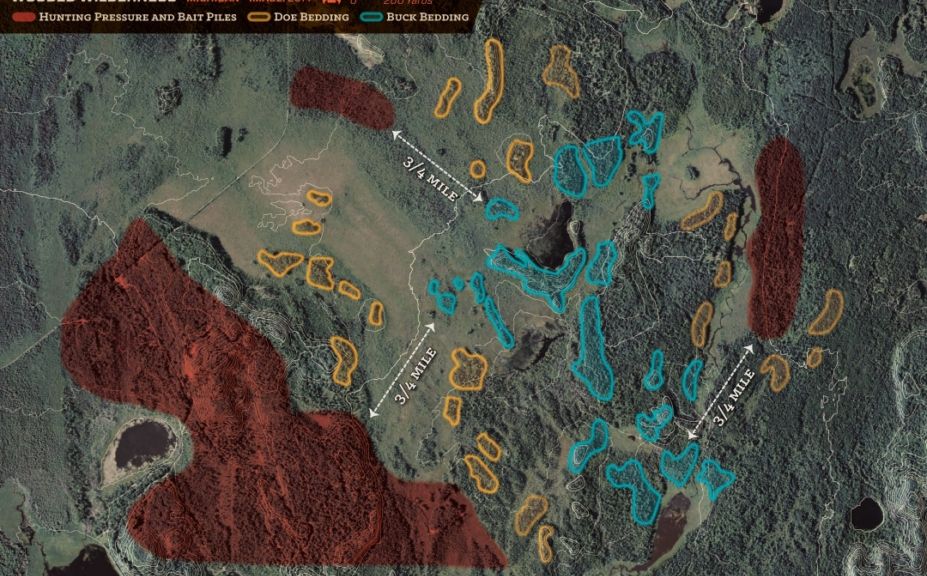
*Using a quality mapping service likeHUNTERRA, is critical for not only your scouting efforts, but for mapping out and designing your habitat improvement program.
Where does a buck bed within Heavily Wooded Wilderness Regions?
Finding where a buck beds in heavily wooded wilderness regions can seem like an extremely daunting task. Often, the deer numbers are low, the cover is extremely thick, and many northern habitats can include numerous natural waterways, making navigation extremely difficult. Due to the over-abundance of cover a reclusive old monarch will travel deep into the timber to distance himself from the stress of hunting pressure, often choosing bedding locations a 1/2 mile to a mile or more away from potential high risk locations. For a little perspective, the diagram included above, represents an area roughly 3 miles wide. However, don't be discouraged, because once you understand where and why a buck chooses to bed, the majority of the habitat can be removed from your potential scouting efforts. Here are 3 common bedding locations within wilderness settings:
1. Isolated Marsh Islands
-Once a buck has traveled a sufficient distance into the cover to be completely removed from the stress of other deer and hunters, he will choose a location that offers him a "room with a view". That doesn't necessarily mean that he will choose the highest point in the land, but that he will take advantage of habitat types that allow him to see long distances, often 50 to 75 yards or greater. Remote islands that serve as connection points between large blocks of cover are often utilized by mature bucks seeking low stress, bedding opportunity that allows him to easily detect approaching danger.
2. Interior Ridge Systems
-Interior pockets of mono-culture habitat types can seem overwhelming, and they are, if you attempt to scour the entire section of land. Instead of walking through a maze of leg-grabbing habitat in search of a needle in a haystack, just turn on your favorite GPS arial app, and focus on the combination of habitat and elevation changes. Even a 1' change in elevation in otherwise flat terrain, can create a change in the variety of habitat. Tag alder flats can transition into cedar swams which eventually can change into open hardwood settings. Whitetails are creatures of edge, and finding a subtle change within an otherwise sea of boredom, can lead to a highly valuable mature buck honey hole, that many hunters often dismiss.
3. Swamp Edges
-As long as a buck isn't backed into corner of unescapability, the edge of a swam can provide everything that a buck needs to within a daytime hotspot. Asside from all the water that he requires, swamp edges create an abundance of habitat change that provides both cover and a diversity of food. A long sloping swamp edge with an escape through the wetlands, can be the perfect spot to walk into with favorable winds and face, while leaving enough cover between you and the potential buck bedding edge to not spook a buck within. Making sure that you are located between the edge and a buck's afternoon food source (in this case a wide variety of distant bait piles including corn, sugarbeats and carrots), can create a great opportunity for harvest, well before dark.
Heavily Wood Wilderness Hunting Strategies:
In large, unbroken tracts of private or public land, often 90% or more of the land can be ignored for your buck bedding scouting efforts. Think Big!. While an alignment of food to doe bedding to buck bedding can take place within a space of 200 yards or less in wide-open low cover ag regions, the same can not be said for big woods and wilderness areas. Although a buck's daytime bedding area may still only include a few acres or less, the effects of hunting pressure and deer related herd stressors, can carry a much greater, far reaching impact. My personal buck harvests within the area included in this diagram, have been spaced by miles, instead of a couple of hundred yards or less. This is also where my access routes have included the most unrecognizable, and legthy routes. Why is "unrecognizable" important? Because on public land in particular, hunters follow hunters. Even in the locations that I park, I avoid crushing ferns and other forms of vegetation, as well as boot track holding sand or mud traps, to make sure that I am not followed. However, once you plan a long distance access route that takes you through deer-less portions of the habitat and around solid blocks of hunting pressure, you can then hone in on the changes in habitat that dictate remote, mature buck bedding areas. It is in these locations that the history of sign, that reveals the use by mature bucks over many years, is more critical than current sign. Current sign is great to see, but it often created during the most prime of hunting opportunities such as the entire rut and the first few days of gun season, as mature bucks are slowly pushed into remote corners of the landscape by ever increasing levels of hunting pressure.
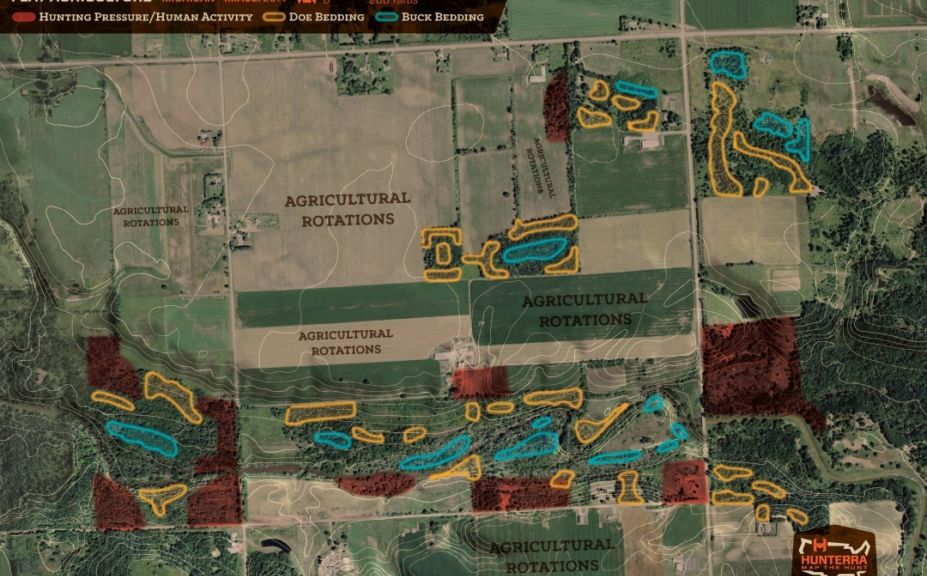
Where does a buck bed within Flat Low-cover Agricultural Settings?
What is the opposite of a heavily wooded Northern wilderness setting and wandering monarchs? A low cover, flat, agricultural region, dominated by small woodlots and tightly packed deer herds. Although dozens of deer may be forced into limited space, a mature buck will still do his best to find a portion of the habitat that he can still call his own. While spending over a decade in this section of land during the late 80s and the majority of the 90s, I eventually became addicted as a mature buck hunter. Hunting the fairly level ag lands of Southern MI, taught me not only the value of predatory access, but the reward of discovering the few hidden portions of the landscape that could successfully house a buck. Here are my favorite 4 bedding habitat types that I relied on to create numerous buck encounters, within the area:
1. Exterior Edge Habitat
-The bedding areas located in the Northeast corner of the diagram were the perfect out-of-the-way locations to attract mature bucks. Flanked by cow pastures on the North side, the edge bedding habitat offered a dead-end of cover, well positioned away from high stress ag fields, hunting pressure, and a large doe herd.
2. Interior Woodlot Ditch System
-Some of the most predictable buck bedding areas in small woodlots are created within the banks of an interior ditch system that cuts through the habitat. However, the size of the woodlot matters greatly! For example, the small, 5 acre woodlot on the west side of the central 10 acre patch of cover, was just too small to house both does, and bucks.
3. "Deep Woods" Opportunity
-Literally, with woodlots averaging between 5 and 20 acres, and chunk of ground containing 30 acres of cover or more can create a deep woods setting, relatively speaking. Even when nearly surrounded by hunting pressure, the SW corner woodlot created enough depth to allow a buck to find his own daytime bedding area within the center. The habitat change of a slight depression flanked by a line of conifer, served to highly define the location.
4. River System Meanderings
-It is no secret that a river, creek or stream that snakes through the middle of open ag land can create the perfect setting to define exactly where a buck beds. However, even if paralled by cover on both sides, it may not be enough! IF there was enough habitat to allow for doe bedding away from hunting pressure, and IF a there was enough cover to hold a mature buck (often at least 50 yards wide) between the combination of hunting pressure, food and doe beds; then opportunity will be created. The waterway that snaked its way along the South side of the diagram, at times, held HUGE deer numbers, including bucks. The natural funnel surely helped as well, but the continuous combination of irregular widths of cover created signficant bedding opportunites for both bucks, and does.
Flatland Agriculatural Hunting Strategies:
During the late 80s and early 90s, these specific bedding areas created the opportunity for over 20 buck kills. Although I progressively improved like most young hunters, I sure wish I had a lot of those opportunities back on a few of the older bucks that I missed with a bow! However, even the errant shots taught me the value of not only finding buck bedding areas, but even more importantly, protecting and preserving those buck bedding areas. During the afternoon hours I found a great deal of success by letting the wind direction dictate which stand I chose to ambush a specific buck from, after he left his bedding area from 75-150 yards away from the stand location. Although my evening hour opportunities were great in number, my best mature buck opportunities came from stalking a morning stand opportunity through the low-attraction portion of the ag rotations, and into the backside of a buck's bedding area with the wind blowing back towards a "non deer" area. Often a quality morning sit meant walking well out of my way to avoid the current, attractive portion of the ag rotation (always changing), before entering the edge of a bedding area long before the deer cleared the fields, where they spent the majority of their night time hours.
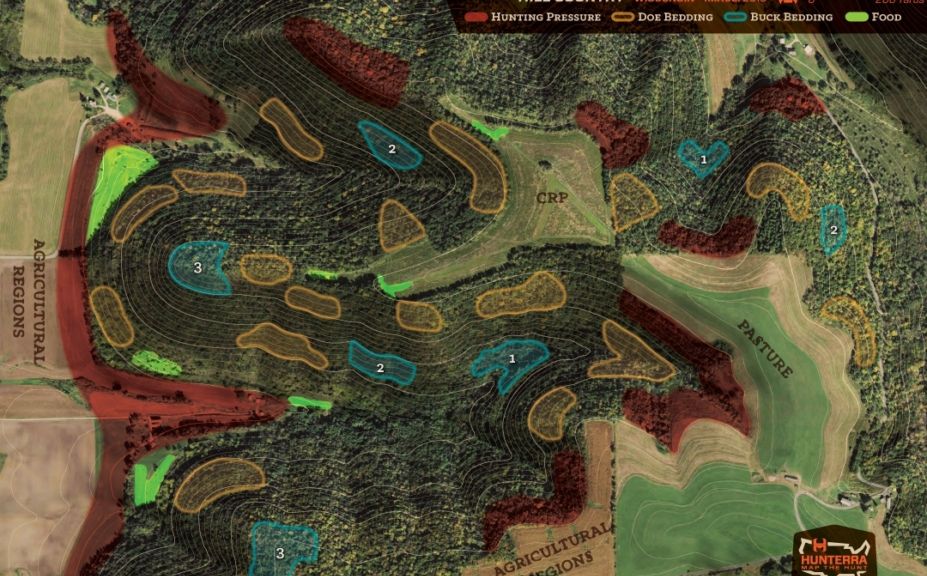
Where does a buck bed within Extreme Hill Country Parcels?
The combination of high quality cover, steep terrain and fertile ag lands, creates the perfect opportunity for giant, hill wandering monsters. But not all portions of the habitat are created equal. Similar to heavily wooded wilderness parcels, a large portion of the habitat can be ignored, for your most intense scouting efforts.The phrases of bucks bedding in the "upper 3rd", "sun facing slope", "military crest" or any other specific location used to described the #1 preferred buck bedding area, can be largely ignored when it comes to actually locating highly attractive buck beds in the field. When it comes to bedding by elevation, deer in generally will follow very stict changes in elevation, while prefering to bed almost exclusively on flat portions within the changing topography. Even a move of 1' or less from a high quality flat or bench, can take a deer off of a flat, onto a steep face, and into non-bedding terrain. Habitats that feature some of the sharpest terrain changes, can be the easiest to scout and define potential bedding terrain, because a large % of the landscape can be erased from not only where deer will travel, but specifically where they will bed. Does a buck bed High, Low or Somewhere Between? The answer: All Three:
1. Low Flats
-Some of the most consistently used buck bedding areas that I locate in hill country parcels around the country each year, are those that are centered around low flats. A low flat will feature a significant change in elevation, for sometimes as little as a 1/4 acre, to as large as 3-4 acres or more. The majority of these potential buck bedding locations are not necessarily the lowest elevation in the area, but instead are tucked back into the lower portions of a draw or hollow, and well away from high traffic doe bedding locations, and hunting pressure hot spots. Flats that are out of the way of consistent hunter traffic, behind doe bedding opportunity, and away from open ag fields or pastures, can features some of the best November buck bedding sign that you will ever encounter. In fact a large % of the mature bucks that I kill with a bow often exit from these areas before I release an arrow, and then run back to their death in these after the shot. Low flat bedding areas are incredibly tough to hunt due to the unpredictability of swirling winds and poor access options, but they should often be protected at all costs due to their incredibly high probability for producing mature buck bedding opportunity nearly every hunting season. Low flat bedding areas can be one of the most predictable bedding areas on a hill country parcel, if you as a hunter let them be.
2. Mid Range Benches and Points
-When determining where a buck beds anywhere, the alignment of hunting pressure, doe bedding, food and cover is important. However, when scouting for mid range benches and points that may potentially house an old recluse, the alignment of habitat becomes critical. In general terms when large ag fields or quality food plots are low, bucks will be high(er), and when quality food is high, bucks will be low(er). However the alignment of habitat can become complex when hunting pressure is low and major food sources are high, hunting pressure is high and food sources are low, or any other number of changing variables are thrown into the landscape, that alter a structured alignment of food to doe bedding to buck bedding. This is where a quality, mid range benches or points can create outstanding levels of bedding potential, if there is enough room (typically 75-100 yards or more of quality habitat separation), between upper and lower doe bedding areas.
3. Upper Points
-While the crest of various topographical points could be hot spots for determining where a buck beds, they are often too exposed, to meet the low-stress bedding requirements of a mature buck, in particular during the hunting season. The actual crest can be a great Summer bedding area, where bucks can be exposed to cooling winds and often open, low stem count cover options, but most Summer bedding areas are not Fall bedding areas, when it comes to bucks. Instead, the military crest, is often chosen by bucks. A military crest is below the actual crese of a ridge top, and is basically the 2nd crest that you will find, before dropping over the edge and down the slope. In fact, I have shot a fair number of mature bucks while looking down into these areas, after approaching from the top, with most major food sources located 200-300 yards below, or several hundred yards to the side. Bucks in these areas can be tucked away from the exposure of cold winds from above, while enjoying a commanding view of lower habitat elevations. They can also take advantage of the scents carried by rising thermals, typically from just after daybreak, to until the temperatures stabilize during the hours of early afternoon. Due to the rising thermals it is nearly impossible for a buck to smell anything from above, but the hidden nature of the location and rising thermals still creates an outstanding combo for a potential high quality bedding location.
Extreme Hill Country Hunting Strategies:
With nearly 3 dozen mature buck opportunities (bucks 4 years old or older) during the last 2 decades (many specifically relating to the above diagram's illustrated buck bedding areas), a great passion and love for hunting mature bucks within extreme elevation changes, has been forever forged. While I rarely take the risk of hunting a low flat because I try to avoid spooking mature bucks in the sanctuary of their preferred daytime bedding areas at all costs, I will definitely push the envelope on mid range to upper benches or points. Since I first began hunting extreme hill country whitetail settings within the hills of PA in 1993, I have been able to observe 1000's of deer with bow range, as they have passed below my treestands. Just in the diagram above alone, I was able to experience the harvest of over a dozen mature bucks (most with a bow), as they traveled at a lower level of elevation than the base of my treestand, within various mid range to upper points and benches. I set a high % of my treestands to take advantage of morning movements below my position, most of those become my favored mature buck stand locations, and the great part about those stand locations, is that deer rarely catch my scent.
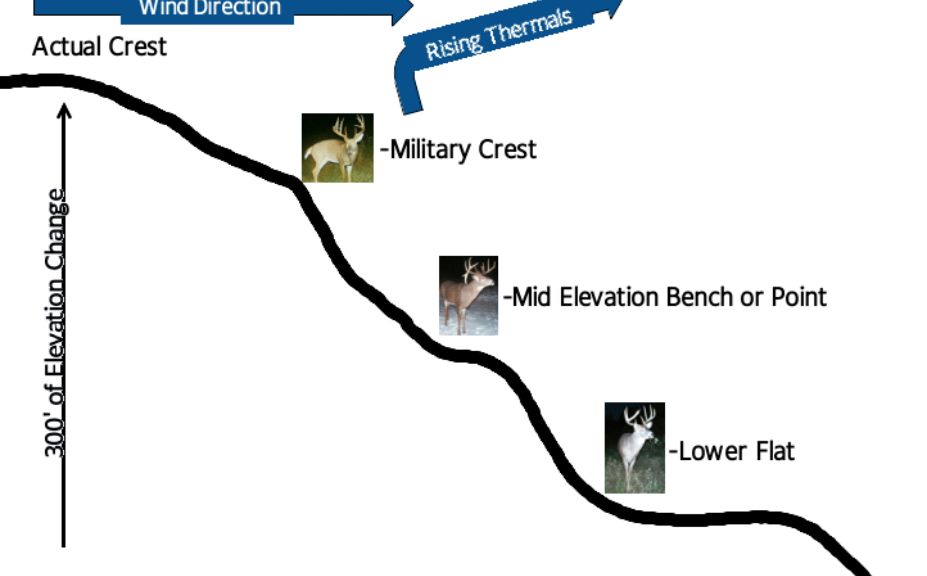
*Are wind directions and elevation changes creating a tough hunt for you? To help unravel the secrets of using the wind to your advantage, make sure to read, "How to Hunt Whitetails in the Wind" or "The Unfair Advantage of Whitetails and Topography".
Although some talk about a churning wind tunnel within the military crest, where bucks can scent above and below at the same time, I have not experienced this to be factual in the field, in any way. In fact I have based my hunting success on that fact, for over 2 decades. My preferred stand locations allow me to access from above with the wind at my back, and into the rising thermals from below. Although there is a brief period of time right before and just after daybreak when the wind direction is settled and not rising until temperatures increase, that is no problem. The mature buck bedding locations that I hunt are far enough away from field edges and food sources, that I do not expect to see a mature buck until a sweet spot of an hour to 4 hours after first light. However, when the temperatures begin to climb, the thermals will begin to conistently lift from below, creating a vaccum that begins sucking my scent up and away from the actual crest of the ridge, and then harmlessly above and over the hollow. A morning stand position above the expected line of deer traffic, often creates the perfect setup, to take advantage of cruising mature bucks that are scenting the rising thermals from below, to scent check for receptive does. And if a mature buck happens to cruise above you? Your scent should be taken away from the hillside, so that he will not detect you from above, or below.
Where does a buck bed on the lands that you hunt?
By following the diagrams from above, you should find that you have enough of a selection of potential prime buck bedding areas on your land to not only scout and find if they are already there, but to create if they are not. Heavy hunting pressure areas, major food sources and potential doe bedding locations are fairly easy to find in any habitat, and if doe bedding areas are stumping you, just look locate the first layer of adequate bedding opportunity adjacent to a major food source. However, the rest of the habitat can at first seem like a sea of randomness, when locating buck bedding areas. If you follow the above bedding areas in the diagrams, I have found can not only reduce the randomness of potential buck bedding areas, but that you can eliminate the majority of acres to specifically scout, to create dependable, high quality setups for mature buck stand locations.
The maps contained within this article were provided by HUNTERRA. For more information about how to map all of your hunting needs, make sure to check out www.hunterra.com.
